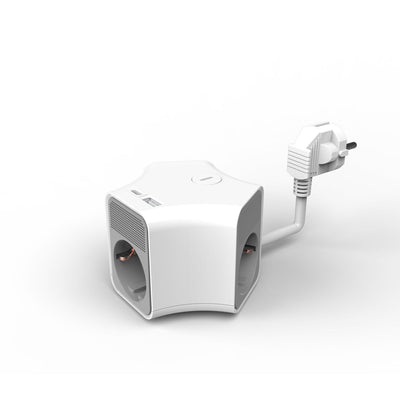
3-Way
A 3-way power strip allows you to turn one wall socket into three usable power points. These compact and versatile accessories are invaluable in situations where you need to connect a limited number of devices but a direct socket is not available. They come in handy in various settings, such as a home office, living room, or workshop. Thanks to their specific design, these power strips offer a practical solution for efficiently organizing your power supply.
Which Type of 3-Way Power Strip Suits Your Needs?
The market for power strips offers several variants of the 3-way version. Choosing the right power strip depends on your specific requirements and the environment in which it will be used.
- Standard models with or without switch: The most common models provide three grounded or ungrounded sockets. Versions with an on/off switch allow you to cut off the power supply to all connected devices at once, which can help reduce standby power consumption.
- Power strips with USB ports: For directly charging smartphones, tablets, and other USB-powered devices, there are 3-way power strips that integrate one or two USB ports. This reduces the need for separate USB chargers and keeps sockets available for other devices.
- Models with surge protection: Sensitive electronics such as computers, televisions, or audio equipment can be protected against sudden voltage spikes (for example, from lightning strikes or network disturbances) by using a power strip with surge protection. An indicator light often shows whether the protection is active.
- Compact strip and cube-shaped models: In addition to traditional strip formats, there are also compact 3-way power strips in block or cube shapes. These take up less space and are convenient for desks or small areas.
Always consider the required cable length, the presence of child safety protection, and the orientation of the sockets (for example, 45 degrees rotated for angled plugs) to make a functional choice.
Key Considerations When Choosing a 3-Way Power Strip
When purchasing a 3-way power strip, certain technical aspects affect both functionality and safety. Here are the most important points to keep in mind:
| Specification | Explanation |
|---|---|
| Grounding | Check whether the power strip is grounded (protective earth in the Netherlands, pin earth in Belgium). Grounded sockets provide extra safety in case of malfunctions or short circuits by diverting any potential leakage current. Devices with metal casings usually require a grounded socket. |
| Maximum load (Watt/Ampere) | Every power strip has a maximum electrical load capacity, generally expressed in Watt (W) or Ampere (A). This indicates the total power that connected devices may consume together. For most household applications, 3680W (at 16A and 230V) is sufficient. Do not connect high-power appliances (such as heaters or heavy-duty tools) together on a single power strip if doing so risks exceeding the maximum load. |
| Cable type | The cable type, often indicated as H05VV-F 3G1.5, provides information about the cord's properties. 'H05VV-F' refers to a flexible PVC cable suitable for light to medium indoor use. '3G1.5' means the cable has three wires, each with a cross-section of 1.5 mm², suitable for most household appliances. |
| Child safety | Many modern power strips feature integrated child safety. This means the socket openings are shielded and only open when simultaneous pressure is applied to both contact points, as with inserting a plug. This reduces the risk of small objects being put into the sockets. |
By comparing these specifications, you can select a power strip that fits your safety and usage requirements.
Practical Questions About 3-Way Power Strips
For daily use of 3-way power strips, certain practical questions regularly arise. Here are answers to some common situations:
Can I connect multiple 3-way power strips together?
No, it is strongly discouraged to connect multiple power strips, regardless of the number of sockets, together. This practice, also known as 'daisy-chaining,' increases the risk of overloading the outlet and the power strips themselves. This can lead to overheating, short circuits, and even fire. Instead, use a single power strip with enough sockets for all your devices, or provide additional wall outlets.
What if the cable of my 3-way power strip is too short?
If the standard cable length of a 3-way power strip isn't sufficient, it is advisable to choose a model with a longer cable, available in various lengths such as 3 or 5 meters. It is better to purchase a power strip with the correct cable length than to use an extension cord in combination with the power strip, to avoid unnecessary connections and potential bottlenecks.
Are all 3-way power strips suitable for outdoor use?
No, most 3-way power strips are intended for indoor use only. For outdoor applications, you must use a power strip with an appropriate IP rating (Ingress Protection). A minimum of IP44 indicates protection against splashing water and solid objects, making it suitable for sheltered outdoor environments. Even higher IP ratings (e.g. IP65 or IP67) are required for unsheltered areas. Always check the product information carefully.
Maintenance and Lifespan of 3-Way Power Strips
A 3-way power strip generally requires little maintenance. Regular visual inspections for damage to the cable or housing are sufficient. Ensure the power strip is not subjected to overloading and that cables are not kinked or pinched. If you notice visible damage, overheating, or a burning smell, the power strip should be disconnected and replaced immediately. A 3-way power strip that is used correctly will generally last a long time.



